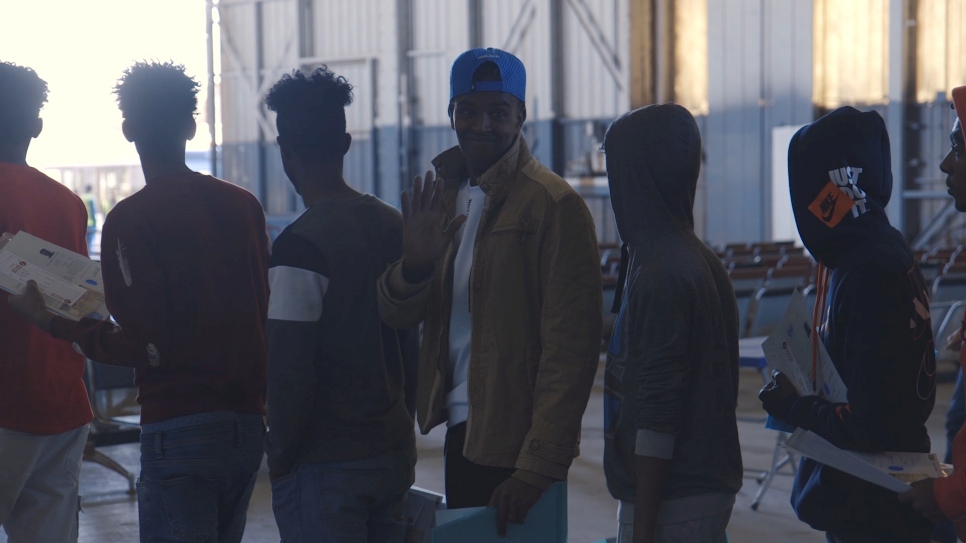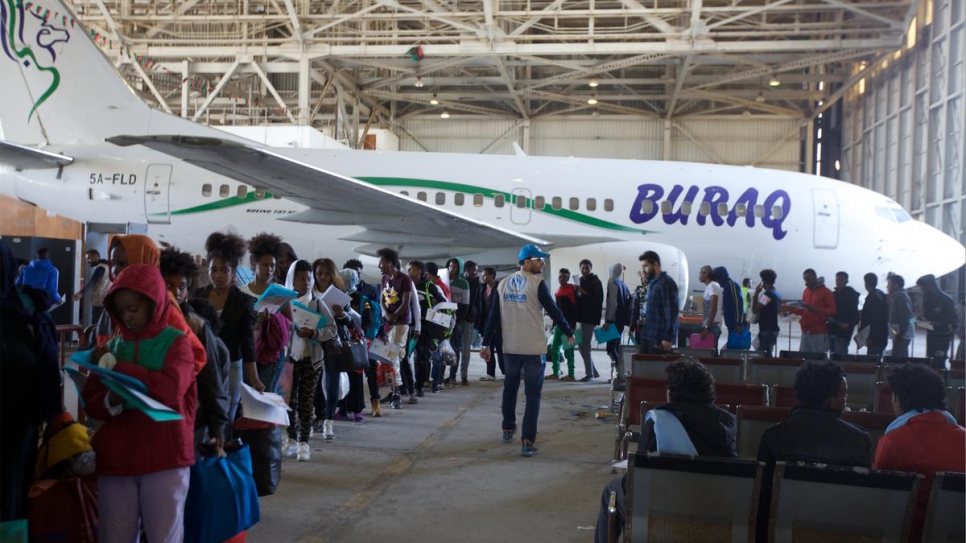report from UN High Commissioner for Refugees
Published on 24 Jan 2019 — View Original

UNHCR staff members advocated for the release of 2 Eritrean kids from Kararim detention center near Misrata, in order to reunite them with their mother in Switzerland
© UNHCR/Sufyan Ararah
By Tarik Argaz in Tripoli, Libya | 24 January 2019
Last March, as they languished in a detention centre in the Libyan city of Misrata, Kedija* and her brother Yonas’s epic attempt to reunite with their mother in Switzerland after eight years of separation had appeared doomed.
Up to that point, the siblings from Eritrea – aged just 15 and 12 – had fled their homeland, survived alone in an Ethiopian refugee camp, been held for ransom by kidnappers, and finally made it aboard a vessel heading across the Mediterranean to Europe, only to be intercepted and returned to Libya.
But thanks to the doggedness of their mother Semira, the intervention of governments and humanitarian agencies, and a large slice of luck, today the children are sitting in Switzerland in their mother’s arms once more.
“I never lost hope of being reunited with my kids again.”
“Despite being separated for more than eight years, I never lost hope of being reunited with my kids again,” said Semira, gripping them tightly as if they might still disappear, with tears of joy and relief running down her smiling face.
For UNHCR, the UN Refugee Agency, it all began with a phone call to staff in Libya from the International Social Service – a Swiss-based NGO specialized in child protection issues – whom Semira had contacted for help.
Knowing only that the children were being held somewhere in the country, and with just their names and an out of date photo to identify them by, UNHCR staff and their NGO partners in Libya began scouring every detention centre they had access to.
But with an estimated 3,800 refugees and asylum seekers currently being held in dozens of official detention centres across the country, and others falling into the hands of armed groups and human traffickers, the chances of finding them were slim.
When UNHCR Senior Protection Assistant Noor Elshin came across two skinny and pale children in Misrata’s Karareem detention centre, they looked so unlike the happy and healthy faces in the photo that staff had been given that it was a shock to learn that he had indeed found Kedija and Yonas.
“This is literally like finding a needle in a haystack,” Noor said. “Despite having them in front of me, I still couldn’t believe that we’d actually found them.” Shortly afterwards, Semira received the call that she had been praying for – her children had been found.
The family’s odyssey began in 2010, when Semira was forced to flee persecution in Eritrea. Rather than drag her children into the unknown, she took the difficult decision to leave them with their grandparents while she sought a safe refuge for the family.
After five years of relative stability, in 2015 Kedija and Yonas were themselves forced to flee insecurity in Eritrea and cross the border into Ethiopia. Semira lost contact with them for several months while her brother, who was also in Ethiopia, desperately searched for his niece and nephew.
He eventually found them living alone in a refugee camp near the Ethiopia-Eritrea border, and pledged to do all he could to reunite them with their mother, who by now was living in Switzerland.
In mid-2017, the children and their uncle set off on their perilous and uncertain journey to reach Semira. The trio battled fierce temperatures, thirst and hunger as they begged rides on trucks and buses across Ethiopia and Sudan, striving to reach the southern shores of the Mediterranean Sea.
But events took a dark turn at the Sudanese-Libyan border, where the group were violently abducted by smugglers, who found out the children’s mother was living in Switzerland and demanded a ransom in order to free them.
When Semira was unable to meet the criminals’ financial demands, Kedija and Yonas were separated from their uncle before being sold on from one smuggler to another, terrified and more vulnerable than ever.
Then one day, several weeks into their ordeal, the siblings were unexpectedly released and left to wander lost and alone in the vast Libyan wilderness. Miraculously, they were discovered and taken in by a group of fellow Eritreans, who were also planning to take a boat to Europe and promised to bring them along.
When the boat was intercepted and the children returned to Libya and detained, they were able to phone their mother, who by this time was frantic with worry. “I’d spent days and nights praying for them, despite everyone around me losing hope, until the day I heard my daughter’s voice for the first time in several months,” Semira recalled.
Suddenly, eight years of worry and longing fell away.
After UNHCR tracked the children down, the Swiss government agreed to grant them humanitarian visas to join their mother. UNHCR worked with the Libyan and Tunisian authorities to organize the paperwork needed for Kedija and Yonas’ release and transport to Switzerland via Tunisia.
On the morning that UNHCR staff entered the detention centre to take the children on their final journey back to their mother, their story was well known to everyone inside. They left the centre with the joyful singing and chanting of their fellow Eritrean detainees ringing in their ears.
Less than 24 hours later, after an overnight stay in Tunis where the Swiss embassy provided them with their travel documents, Kedija and Yonas touched down in Switzerland where an anxious and excited Semira was waiting for them.
Catching the first sight of her tired and disoriented children in the airport arrivals gate, eight years of worry and longing fell away as she ran to them and buried herself in their ecstatic embraces; safe, happy and reunited at last.
Source=https://reliefweb.int/report/switzerland/eritrean-minors-reunited-mother-after-eight-year-odyssey
*All names have been changed for protection purposes


 Eritrean President Isaias Afwerki (left) and Sudanese President Omar al-Bashir (right) during a welcome ceremony in Khartoum, 11 June 2015.Photo: Ashraf Shazly/AFP
Eritrean President Isaias Afwerki (left) and Sudanese President Omar al-Bashir (right) during a welcome ceremony in Khartoum, 11 June 2015.Photo: Ashraf Shazly/AFP Abiy Ahmed (right) and Isayas Afeworki (left)
Abiy Ahmed (right) and Isayas Afeworki (left)









 Eritrea is characterised by harsh climatic conditions, including cyclical drought, which affects groundwater resources, and flooding during rainy seasons. These events exacerbate the vulnerability of communities, making it difficult for families to fully recover from the effects of one emergency before being affected by another. In recent years, the country’s climatic conditions tested the coping capacities of the population, of which 80 per cent iare dependent on subsistence agriculture.
Eritrea is characterised by harsh climatic conditions, including cyclical drought, which affects groundwater resources, and flooding during rainy seasons. These events exacerbate the vulnerability of communities, making it difficult for families to fully recover from the effects of one emergency before being affected by another. In recent years, the country’s climatic conditions tested the coping capacities of the population, of which 80 per cent iare dependent on subsistence agriculture.

















